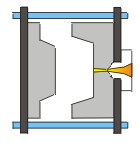Various Forms of Aluminum Casting
Aluminum is considered versatile, first and foremost because it is one of the only metals around that can be cast using all sorts of casting processes. Die casting, sand casting, plaster casting, continuous casting, investment casting and permanent mold casting, in this case, all fall under aluminum casting. Squeeze casting, lost foam, and hot isostatic pressing are also some applications associated with the process.
When deciding on which process of aluminum casting to use, one must take into consideration the cost of each type and the quality of material that it will yield. Many aluminum alloy castings are made using the above processes, but the difference in results are great and many in number. For example, when die casting, air can be trapped in the casting and thus results in porosity. It cannot be eliminated, and aluminum die castings are thus lower in strength than mold castings.
Die casting is mostly catered towards aluminum alloys because it is considered the best material for the process, and it is easy to obtain. It is also the most popular aluminum casting process and is good for mass production of small, detailed parts. Millions of copies of alloys are produced to serve as parts for various machines and tools, seen everyday in one’s life. Many house tools are made using aluminum die casts, and many structures outside also require similarly small parts. Permanent mold casting, on the other hand, is better suited for much larger parts and thus yield in stronger material for much bigger mechanical structures.
Cast Parts Company makes parts in
A380 Aluminum Alloy Parts and in
#3 Zinc Alloy Parts using a high pressure casting process.Click this link if you are looking for
Die Casting Part Prices.
look at this webpage
Die Casting Metal Alloys for material information.
This is where you find information on
High Pressure Casting Process
Contact:
Cast Parts Die Casting Company
818-982-9386
Sales@Cast-Parts.com



